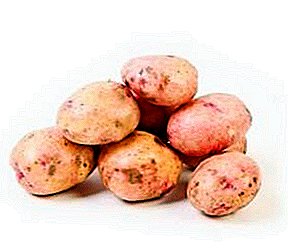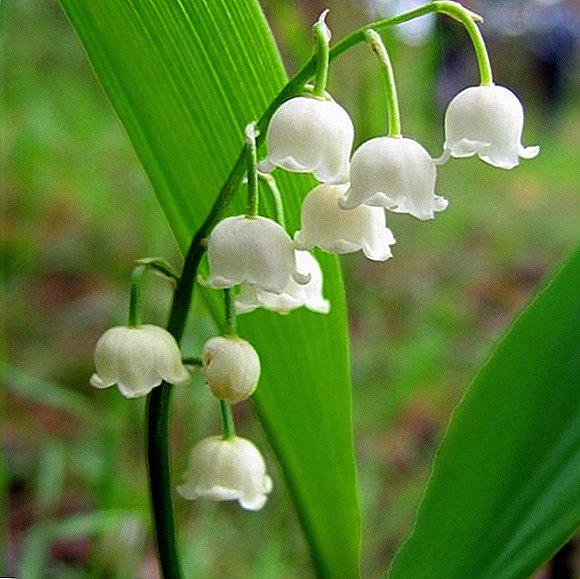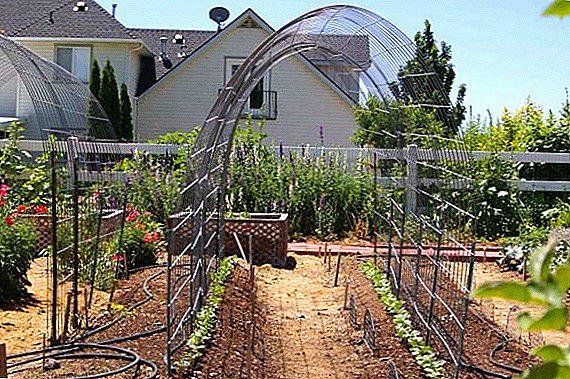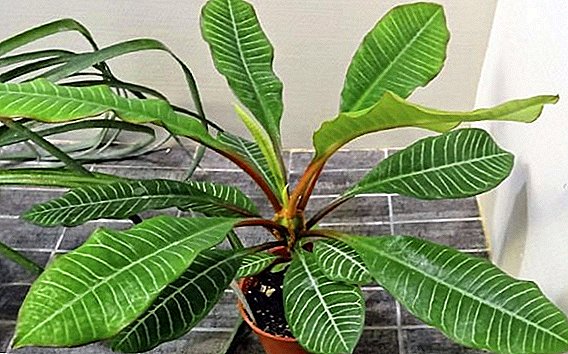 Spurge - a guest from the tropics, but today this plant adorns the usual garden plots, office buildings, offices and homes. The plant has more than one and a half thousand species, the most diverse in size and shape of leaves and flowers, the presence or absence of thorns. Today we will understand how different types of room euphoria look, using photos, find out their exact names, briefly discuss the subtleties of caring for them.
Spurge - a guest from the tropics, but today this plant adorns the usual garden plots, office buildings, offices and homes. The plant has more than one and a half thousand species, the most diverse in size and shape of leaves and flowers, the presence or absence of thorns. Today we will understand how different types of room euphoria look, using photos, find out their exact names, briefly discuss the subtleties of caring for them.
White-clotted (Euphorbia leuconeura)
Belozhilchaty this plant, popular in culture of window plants, is called for white streaks on a juicy green background of leaves and on edges of a trunk. The white color is due to the concentration of the milky juice. A young plant is a lush rosette of large bright green leaves, wide and rounded on the edge, dense to the touch, with a glossy surface.
Spurge, like cactus, sansevieriya, hibiscus, spathiphyllum, zamiokulkas, Christmas tree, chlorophytum, tradescantia, are classified as unpretentious houseplants. They are able to create home comfort without any special care costs.
 An adult plant, as it grows, forms a thick pentahedral stem that is woody at the base, and at a respectable age it may branch out, forming bizarre shapes, such as a figure chandelier. In the period of flowering in the axils of the leaves appear inconspicuous peduncles, inconspicuous white small flowers, more like sprouted bulbs. In the peduncle buds, there are seeds that can shoot four meters away from the plant. Euphorbia belozhilchaty does not require special care and attention at home, however there are a few rules:
An adult plant, as it grows, forms a thick pentahedral stem that is woody at the base, and at a respectable age it may branch out, forming bizarre shapes, such as a figure chandelier. In the period of flowering in the axils of the leaves appear inconspicuous peduncles, inconspicuous white small flowers, more like sprouted bulbs. In the peduncle buds, there are seeds that can shoot four meters away from the plant. Euphorbia belozhilchaty does not require special care and attention at home, however there are a few rules:
- watering - as the soil dries, no more; spraying is necessary during the hot period;
- lighting - saturated, but not in direct sunlight;
- temperature - room temperature, 18-23 ° С;
- air humidity is moderate;
- the capacity for the content is rather wide than deep;
- the composition of the soil unpretentious, transplantation of young specimens - annually; adults older than five years - every two years.

Important! The milky sap of a plant is poisonous; it is advisable to protect the skin and eye mucosa when working with it, in order to avoid severe burns.
Bluish (Euphorbia coerulescens)
Euphorbia bluish got its name due to wax coating on the green part. This type of euphorbia can multiply vegetatively, therefore it grows rather quickly, occupying a large area. The stem of the plant is thick, up to 50 mm in circumference, has from four to six faces with tubercular horny formations on the edges.  Instead of succulent leaves, a dark brown thorn bifurcated in the form of horns, often also covered with bloom. Strong voluminous spikes more than a centimeter in length.
Instead of succulent leaves, a dark brown thorn bifurcated in the form of horns, often also covered with bloom. Strong voluminous spikes more than a centimeter in length.
Succulents are plants that do not require frequent watering. In addition to milkweed succulent plants also include aichrizone, echeveria, agave, aloe, echinocactus, nolin, slipway, kalanchoe, and cinquefoil.
This species prefers penumbra and moderate watering, it can be fertilized only in summer. During the rest period, he needs coolness, but not lower than +12, watering for this period stops. 
Enephorbia meloformus
Euphorbia meloniform has a rounded shape, up to 10 cm in height, grows in width from 5 to 10 cm. As it gets older, it is overgrown with numerous children closer to the base. The rounded thick stem process has a triangular-shaped facet - from eight to twelve.  The color may be gray-green, marsh color, light green and with a bluish tint. The ribs are covered with convex tubercular formations, and the faces are often decorated with transverse stripes of brown, dark green or gray color. In the upper part (mainly in females) solid peduncles with small green-yellow or reddish flowers are formed.
The color may be gray-green, marsh color, light green and with a bluish tint. The ribs are covered with convex tubercular formations, and the faces are often decorated with transverse stripes of brown, dark green or gray color. In the upper part (mainly in females) solid peduncles with small green-yellow or reddish flowers are formed.
Room melon euphorbia likes moderate humidity, loose, light and nutritious soil with mandatory drainage. 
Important! In winter, the plant is not watered; in rare exceptions, a soil ball is sprayed slightly.
Fat or fat (Euphorbia obesa)
There is some similarity of this species with the species described above: the thick stem has a rounded shape, it is also small - up to 12 cm tall and 8 cm in circumference. The trunk is also divided into segments, although not so pronounced and with slightly convex ribs. The difference lies in the absence of spines on the plant. The color of euphorbia is fat - gray-green or dark green, with dark stripes. Single inflorescences, collected in a bunch at the top of the trunk.  Euphorbia obese loves deep pots, moderate watering as the soil dries. In winter, the plant is at rest.
Euphorbia obese loves deep pots, moderate watering as the soil dries. In winter, the plant is at rest.
Canary (Euphorbia canariensis)
Under natural conditions, a bushy bush reaches three to four meters in height; at home, of course, much less. This succulent has a fleshy trunk of four or five faces, with clearly traced edges, without foliage. The ribs are protected by double-pointed spines growing from half-centimeter long kidney-shaped formations.  He needs pruning, sanitary and formative. Annually, you should cut the top and remove weaker or incorrectly growing shoots - thus you will give it a beautiful shape and heal, rejuvenate the bush.
He needs pruning, sanitary and formative. Annually, you should cut the top and remove weaker or incorrectly growing shoots - thus you will give it a beautiful shape and heal, rejuvenate the bush.
Cypress (Euphorbia cyparissias)
Euphorbia cypress is a herbaceous plant, similar to juniper. It grows strongly in natural conditions and takes the form of a neat little bush. In room conditions, its height does not exceed half a meter.  It has straight stems, densely covered with needle-like, bright green leaves. During the flowering period, dense tufts of inflorescences are formed on the tops of the stems. Small flowers on long stalks are surrounded by bright stipules of a reddish or golden hue.
It has straight stems, densely covered with needle-like, bright green leaves. During the flowering period, dense tufts of inflorescences are formed on the tops of the stems. Small flowers on long stalks are surrounded by bright stipules of a reddish or golden hue.
This species is drought-resistant and better tolerates underfilling than overflow. For lush, bright flowering, he needs bright lighting at least ten hours a day. Feed the plant once a year with a liquid complex mineral composition.
Large root (Euphorbia clavigera)
This type is called a large root because of a modified trunk, similar to a bloated root process protruding from the soil. From the lignified, irregularly shaped bulge, curved light green shoots grow, divided into sections, equipped with long double-pointed prickles along the edge of sharp edges.  At the tops of the shoots in the grooves between the thorns are sessile bud-inflorescences. Yellow, cup-shaped flowers with three to four long stamens make their way from the buds. This plant is most commonly grown as bonsai. He needs a bright light, the temperature is from 22 to 26 ° C, otherwise the care is the same as for the other succulents.
At the tops of the shoots in the grooves between the thorns are sessile bud-inflorescences. Yellow, cup-shaped flowers with three to four long stamens make their way from the buds. This plant is most commonly grown as bonsai. He needs a bright light, the temperature is from 22 to 26 ° C, otherwise the care is the same as for the other succulents.
Did you know? The name Euphorbia euphorbia is mentioned in Pliny's writings. In his "Natural History", he describes a case of the miraculous recovery from a serious illness of the ruler of Numibia. In order to perpetuate the name of Euphorbos’s doctor who saved him, King Juba called his name the plant from which the doctor prepared the life-saving medicine.
Large-horned (Euphorbia grandicornis)
Krupnorogogo euphorbia trigeminal trunk with faces bent inward. It is divided into segments of irregular shape, each upper segment is a continuation of the lower one. On the uneven edges of the edges of one tubercle grow two spikes looking in different directions. In the natural environment, euphorbia blooms with bright yellow dense flowers, practically it does not bloom in indoor conditions.  Under good conditions - bright sunlight, moderate watering and room temperature - the plant is able to grow to the ceiling.
Under good conditions - bright sunlight, moderate watering and room temperature - the plant is able to grow to the ceiling.
Mile (Euphorbia milii)
Euphorbia Mila (Miliusa) is a thorny shrub that, in addition to thorns, also has foliage. On a ribbed gray trunk, closer to the top, juicy green leaves of drop-shaped form grow: narrow at the petiole, they smoothly expand, rounded around the edge. The surface of the sheet plates is smooth and shiny. Blooming, Euphorbia Mile produces long flower stalks, usually with two flowers of pink, white or yellow. The flowering period of the plant begins when it reaches 25 cm in height.  In spring and summer, the plant needs moderate watering and fertilizing, without fail it is necessary to remove dried flower stalks and leaves. During the rest period, the temperature should not be below 12 ° C.
In spring and summer, the plant needs moderate watering and fertilizing, without fail it is necessary to remove dried flower stalks and leaves. During the rest period, the temperature should not be below 12 ° C.
Milk (Euphorbia lactea)
Milky-white euphorbia grows shrubs, white ribbed stem forks as it grows and thickly overgrown with side shoots. The ribs of the shoots are literally dotted with triangular-shaped tubercles that end in spines.  There is a very interesting in room culture form "Cristata": from a thick trunk, divided into three or four faces, blooms in the form of an open, wavy along the edge of the fan, the formation of a milky color, often with a pink border on the edge.
There is a very interesting in room culture form "Cristata": from a thick trunk, divided into three or four faces, blooms in the form of an open, wavy along the edge of the fan, the formation of a milky color, often with a pink border on the edge.
Multifaceted (Euphorbia polygona)
Multifaceted euphorbia is so named for good reason: its trunk sometimes has up to twenty sharp edges. The bush can be with one spherical stem, similar in appearance to the cactus, and may consist of several cylindrical stems. Along the edge of the ribs are brown tubercles-buds and sharp thorns. Dense flower buds are located on long peduncles.  This species prefers to develop in the penumbra. During the rest period, watering is better not to.
This species prefers to develop in the penumbra. During the rest period, watering is better not to.
Triangular (Euphorbia trigona)
A fast-growing species, in room conditions for three years grows up to a meter; due to the branching of the plant, a slim compact bush is formed. But as he grows, he will need support, because the root system is shallow and, due to its own gravity, the bush may break or fall out of the pot.
The sides of the barrel are concave, glossy, bright light green in color. On sharp edges, instead of spines, teardrop-shaped leaves grow with a convex sharp tip and a central stripe along the leaf.  The penumbra or diffused light - the plant develops equally well both there and there. It responds well to liquid mineral dressing.
The penumbra or diffused light - the plant develops equally well both there and there. It responds well to liquid mineral dressing.
Cereus (Euphorbia cereiformis)
Cereus spurge is a large, well-branched shrub with several multifaceted trunks. Gray-green stems at the edges of the ribs are trimmed with large spines up to 2 cm in length, spikes dense and bulky. Leaves grow here and there, but they are so small and weak that they dry up immediately. Some of them immediately flies, some hold on for a long time.  This type of contraindicated direct sunlight, sunburn stains will remain forever. The plant likes spraying, but watering should be only as the soil dries on the surface.
This type of contraindicated direct sunlight, sunburn stains will remain forever. The plant likes spraying, but watering should be only as the soil dries on the surface.
Fisher or Pallas (Euphorbia fischeriana)
Euphorbia Pallas, or man-root, as it is called by the people, really helps men cope with some disorder of sexual function. This is a grassy undersized shrub, branched and leafy. It has thin flexible stems and neat triangular-shaped leaflets, with an almost white stripe along, bright light green color. During the flowering period on the stems small yellow flowers are formed on long peduncles, equipped with a pair of stipules.  After withering, a hazel fruit is formed. But the plant is famous for its root. Thick rhizome has several processes smaller, so that this whole mass resembles a human figure. When studying the composition of the root were found substances that act oppressively on tumor cells.
After withering, a hazel fruit is formed. But the plant is famous for its root. Thick rhizome has several processes smaller, so that this whole mass resembles a human figure. When studying the composition of the root were found substances that act oppressively on tumor cells.
Did you know? Esoterics suggest that the rhizome of Pallas is the famous root of the mandrake. As you know, mandragora was used as an element of magical rituals and as a potent medicine.
Spherical (Euphorbia globosa)
At first glance, the plant resembles an awkward children's crafts. From potato-like rounded stems grow, piling up in a chaotic manner, green shoots of the same shape. On the green spherical stems there are small leaves, and on the tops during the flowering period there are dense inflorescences on long peduncles. All this composition grows in width to half a meter, in height no more than ten centimeters.  The variety prefers penumbra, responds well to summer feeding, during the rest period, watering should be discarded.
The variety prefers penumbra, responds well to summer feeding, during the rest period, watering should be discarded.
Euphorbia is a convenient plant: if you are going on a trip, it will be able to do without your attention for more than two weeks, and in the natural environment without precipitation - even longer. There is one "but" in the content of milkweed at home: as already mentioned, the plant is poisonous, therefore, if there are small children in the house, it is better to discard it.












